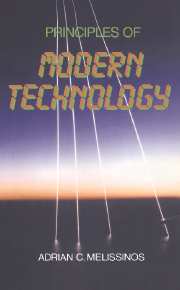2 - Digital electronics
Published online by Cambridge University Press: 03 December 2009
Summary
Modern electronic devices operate in general, on digital principles. That is, signals are transmitted in numerical form such that the numbers are coded by binary digits. A binary digit has only two states: ‘one’ and ‘zero’, or ‘high’ and ‘low’ etc. The reason for relying almost exclusively on digital information is that binary data can be easily manipulated and can be reliably stored and retrieved. That this approach is practical and economically advantageous is due to the great advances in large scale integration and chip manufacture as already discussed. In this chapter we will consider digital systems and the representation and storage of binary data. We will conclude by discussing the architecture of a small 3-bit computer, which nevertheless, contains all the important features of large machines.
Elements of Boolean algebra
In digital logic circuits a variable can take only one of the two possible values: 1 or 0. The rules for operating with such variables were first discussed by the British mathematician George Boole (1815–64) and are now referred to by his name. Since in pure logic a statement is either true or false, Boolean algebra can be applied when manipulating logic statements as well. This material is conceptually simple yet it is most relevant to the understanding of complex logic circuits.
Boolean algebra contains three basic operations: AND, OR and Complement. The result of these operations can be best represented by a truth table as introduced in Section 1.9, where also the symbols for the corresponding circuits were given.
- Type
- Chapter
- Information
- Principles of Modern Technology , pp. 42 - 80Publisher: Cambridge University PressPrint publication year: 1990



